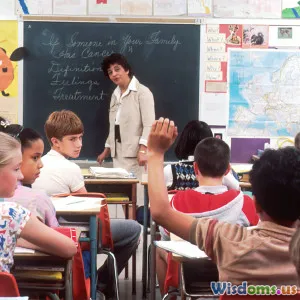
How Education Propelled Social Mobility in Victorian Britain
9 min read Explore how Victorian Britain’s education system spurred unprecedented social mobility, reshaping society and inspiring change through access and reform. (0 Reviews)
How Education Propelled Social Mobility in Victorian Britain
Introduction
Imagine a society where birth largely determines your destiny, and your chances of altering your social standing are minimal. This was the reality in Britain before the 19th century. Yet, through the Victorian era, education emerged as a beacon of hope and a powerful catalyst for social mobility, enabling individuals from modest beginnings to transcend class barriers. But how exactly did education serve as a lever for change in Victorian Britain? What reforms, ideological shifts, and structural changes made this possible? This article journeys through the educational landscape of Victorian Britain, unveiling how access to education reshaped social structures and offered pathways to improved status.
The Socioeconomic Landscape Before Education Reform
Before delving into Victorian Britain’s transformative changes, it’s crucial to grasp the rigid class divides of the preceding centuries. The entrenched hierarchy comprised the aristocracy, landed gentry, middle classes, and an expansive working class, many entrapped in poverty. Social mobility was notoriously limited due to:
- Limited Access to Education: Formal education was primarily reserved for the wealthy. The working class often lacked the resources or time to attend schools.
- Apprenticeship and Trade Barriers: Many had to inherit trades or professions, restricting movement.
- Social Expectations: Class boundaries were reinforced through societal norms.
Historian David Spring noted, “Before education reforms, a family’s fate was inextricably tied to birth, with few mechanisms to break the cycle.” This sets the scene for understanding why Victorian education reforms were revolutionary.
The Growth of Education in Victorian Britain
From Private Tutors to Public Schools
In the early 19th century, education was an exclusive privilege for the upper classes, often conducted at home through private tutors or elite boarding schools. However, this began to change dramatically with the rise of the industrial revolution and urbanization creating new demands for literacy and skills among the masses.
The Elementary Education Act 1870: A Game Changer
One of the landmark moments was the Elementary Education Act of 1870 (Forster Act), which laid the foundation for compulsory elementary education across England and Wales. Its key features included:
- Establishing elected school boards tasked with building and maintaining schools.
- Providing free elementary education to children aged 5-13.
- Making it more difficult for families to avoid sending their children to school.
By the 1880s, school attendance rates rose sharply—from about 50% in the 1870s to over 90% by 1891. This surge in literacy opened unprecedented avenues for working-class children.
Rising Literacy Rates as a Catalyst
Literacy exploded: in 1841, about 67% of men and 54% of women over age 20 were literate; by 1891 these figures rose to near 90%. This surge meant the working class was increasingly equipped to engage with printed materials, participate in political discourse, and acquire skills beyond manual labor.
Education as a Vehicle for Social Mobility
Opening Doors to New Professions
The newly literate working class could now aspire to enter professions demanding reading, writing, and numeracy skills. For instance:
- Clerical and administrative jobs in growing industries became accessible.
- Opportunities expanded in mechanics, engineering, and teaching.
John Bright, a prominent Victorian reformer, wrote, “An educated people is the key to a just society; knowledge is the ladder out of servitude.” This reflects the era’s conviction that education equated to progress.
The Role of Technical Schools and Evening Classes
Victorian Britain didn’t just invest in basic education; specialized technical and scientific instruction emerged to meet industrial needs. Institutions such as the Finsbury Technical College taught skills like mechanics, chemistry, and engineering, often to working adults seeking advancement.
Factories and employers began to encourage technical education to boost productivity, thereby creating a feedback loop encouraging social mobility through skill acquisition.
Women’s Education: Challenging Gender Norms
Victorian education reforms also impacted women, previously marginalized in formal education. The founding of girls’ schools and female colleges—with institutions such as Girton College, Cambridge (1869)—expanded women’s opportunities. Education helped many women enter teaching, nursing, and clerical professions, subtly shifting societal views on gender roles.
Long-Term Impacts on Social Structure
Emergence of a Robust Middle Class
Education contributed to the growth of a more substantial middle class composed of professionals, merchants, and skilled workers. This class wielded increasing economic and political influence, accentuating Victorian Britain’s evolving social landscape.
Political Participation and Empowerment
Education also empowered greater participation in democracy. Literacy and civic knowledge allowed broader segments of society to engage actively in political life, fueling movements such as the push for universal suffrage and labor rights.
Inspirational Case Studies
- Samuel Smiles, author of Self-Help (1859), argued education was central to personal improvement and social advancement, inspiring countless Victorian readers.
- The life of Benjamin Disraeli, who, despite his birth to a Jewish family that was not wealthy, leveraged education and self-improvement to become UK Prime Minister, exemplifies education's role in social ascendance.
Challenges and Limitations
Despite vast progress, it’s essential to recognize ongoing obstacles:
- Quality of education varied widely between urban and rural areas.
- Some working-class children still left school early due to economic pressures.
- Class prejudices persisted in access to higher education and elite professions.
Nonetheless, Victorian education undeniably laid the groundwork for future reforms and the democratization of knowledge.
Conclusion
Education in Victorian Britain was more than a scholastic pursuit—it was a transformative force that propelled social mobility, reshuffling the rigid class structures of the time. From the Elementary Education Act to specialized technical institutions and expanding opportunities for women, education democratized knowledge and empowered individuals to transcend their birth-imposed limitations. The rise in literacy rates alone opened doors to new careers, political awareness, and a burgeoning middle class, carving pathways that would influence British society well into the modern age.
This historical exploration underscores a powerful lesson: access to quality education remains a cornerstone for social advancement. As we reflect on Victorian Britain’s journey, it invites us to champion inclusive and expansive education policies today, recognizing the enduring power of learning to unlock human potential and societal progress.
Rate the Post
User Reviews
Popular Posts




















